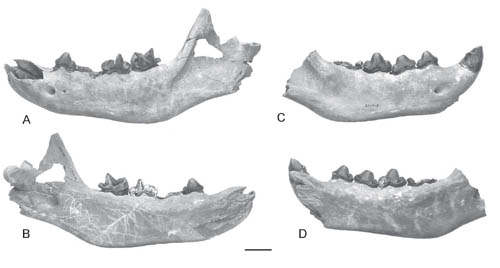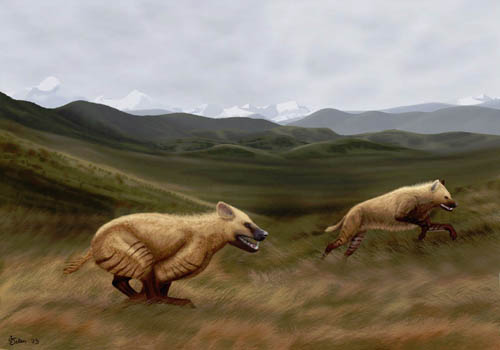| Location: Home > Research > Research Progress |
| New Cursorial Hyena Found From the Late Cenozoic Zanda Basin of Tibetan Plateau |
|
During the 2009 field season, an international team led by Dr. LI Qiang, Institute of Vertebrate Paleontology and Paleoanthropology (IVPP), Chinese Academy of Sciences, discovered skull fragments of a fossil hyaenid from a gully off the northern trail of Zandagou in the late Cenozoic Zanda Basin in southwestern Tibetan Plateau. Researchers described it as a new species of the cursorial hyaenid Chasmaporthetes, C. gangsriensis, in the latest issue of Journal of Vertebrate Paleontology 33(6). The first occurrence of the cursorial hyena Chasmaporthetes on the Tibetan Plateau provides additional evidence for open environments in the western Himalayan foothills no later than the Pliocene, and helps better understand its character evolution during the late Neogene. The new materials, including partial lower jaws, maxillae, and toe bones, were unearthed from the early Pliocene lower part of the middle Zanda sequence, about 4.89–4.08 million years ago based on paleomagnetic and biostratigraphic correlations. Chasmaporthetes gangsriensis is smaller than other Plio-Pleistocene Eurasian records of the genus. The relatively undifferentiated premolars and the short and wide m1 of this new species, along with its smaller size, distinguish it from all known materials in the genus Chasmaporthetes. Metatarsal and phalangeal elements referred to C. gangsriensis are long and gracile, indicating cursorial abilities typical of Chasmaporthetes. Researchers summarized available biostratigraphic and morphometric information regarding Eurasian species of Chasmaporthetes. “With an age of early Pliocene, C. gangsriensis is morphologically the most basal Pliocene Chasmaporthetes in China, and is consistent with the ‘out of Tibet’ hypothesis for some Pleistocene megafauna”, said first author Dr. Zhijie Jack Tseng of Natural History Museum of Los Angeles County and University of Southern California. An evaluation of the biostratigraphic relationships among Asian and North American occurrences of Chasmaporthetes indicates that the genus first dispersed into the New World during the early Blancan North American land mammal age (NALMA) with likely ancestry close to the heterogeneous sample of C. lunensis in Eurasia. The possibility of a second dispersal is indicated by a mixed sample of specimens with significantly smaller p4/m1 length ratio than other Chasmaporthetes. "Recent field work in the Zanda Basin in southwestern Tibetan Plateau has provided new fossil evidence of vertebrate faunas spanning the late Miocene to Pleistocene, which represents new occurrences hitherto unknown in that region of Asia and allows the establishment of a faunal sequence in the basin for the first time. The discovery of this cursorial hyaenid species provides additional evidence for open environments in the western Himalayan foothills no later than the Pliocene, as consistent with previous evidence from Zanda Basin’s fossil horses and herbivore enamel isotope analyses”, said coauthor Dr. LI Qiang of the IVPP. This study was supported by the National Basic Research Program of China (973 Program), Chinese Academy of Sciences, and National Natural Science Foundation of China and National Science Foundation of USA.  Fig.1 Partial left maxilla of Chasmaporthetes gangsriensis (IVPP V18566.1). A, lateral view; B, medial view; C, occlusal view. Scale bar equals 20 mm. (Image by Zhijie Jack Tseng)  Fig.2 Left and right dentaries of Chasmaporthetes gangsriensis (IVPP V18566.3–4). A, lateral view of left dentary; B, medial view of left dentary; C, lateral view of right dentary; B, medial view of right dentary. Scale bar equals 20 mm. (Image by Zhijie Jack Tseng)  Fig.3 Life reconstruction of a pair of Chasmaporthetes gangsriensis in the Pliocene Zanda Basin. (Artwork by Julie Selan) |